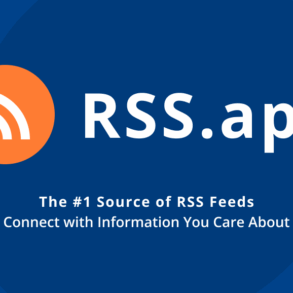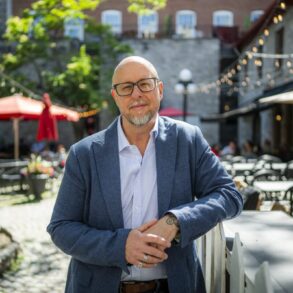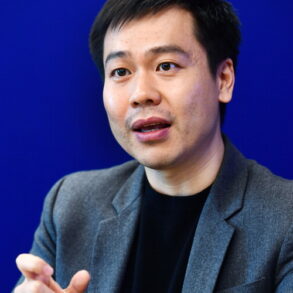ANTHONY ALBANESE, PRIME MINISTER: Hey TikTok …
PETER DUTTON, OPPOSITION LEADER: If you’re watching this TikTok on Wi-Fi…
LAURA TINGLE, CHIEF POLITICAL CORRESPONDENT: When Australians come to vote at this year’s federal election, less than half of the voters are expected to have got the information that will sway their votes from traditional media like broadcast television and newspapers.
The majority will have formed their opinions based on what they see on social media.
It’s been a rapid change.
TONY BARRY, FORMER POLITICAL STRATEGIST: People’s media diets have changed dramatically over the last 20 years, and they’ve even changed over the last 24 months.
Podcasts now, according to recent research, 2 million Australians listen to podcasts daily, and 4 million Australians engage with podcasts weekly. So it’s a huge tool that’s being used, and it speaks to that authenticity and that trust between the host and the audience that political leaders really, really need to capture
DANIEL STONE, STRATEGIC ADVISER: Ben LaBolt, who used to be the communications director for Joe Biden, commented to me recently that, you know, President Biden had done more than 60 interviews over the course of last year, but most people hadn’t seen any of them.
You know that everyone was getting their news through this diffused online social media environment, and that that was one of the things that he suggested that Trump had done really fantastically well was just occupy so much digital real estate online.
LAURA TINGLE: Read scholarly analysis of the rise of the influence of social media 10 or 15 years ago and it almost looks quaint.
Twitter, in those days, was the new phenomenon and the focus was on the online discussions – not the capacity of a multitude of platforms that would let politicians talk directly to voters.
DANIEL STONE: Last year, less than 50 per cent of people watched free to air broadcast television in Australia, the first time in history since the beginning of television, and more and more of those people have been moving to social networks, and that’s where both politicians and their parties are moving to try and reach people.
LAURA TINGLE: One Australian MP who has both used and watched the development of the importance of social media is independent MP Zali Steggall, who unseated a former PM in 2019.
ZALI STEGGALL, MEMBER FOR WARRINGAH: I think the advent of social media and that ability to communicate with constituents through those platforms is really important.
I think it was, I would credit it with one of the reasons as an independent I was able to cut through with my local community and speak very directly, but in a very local way, to people in the community about issues they care about.
So I think social media has revolutionized politics in making it more accessible to more people and not as reliant, with due respect to the ABC, on legacy media.
LAURA TINGLE: Fast forward to 2025 and Opposition Leader Peter Dutton has been conspicuously building his presence on social media platforms like Instagram and TikTok – with lots of content designed to soften his hard man image, as well as focus on tightly targeted podcasts.
TONY BARRY: Dutton is probably performing better in the Liberal campaign in general, in terms of their tapping into these vertical markets. And I saw Dutton did something with Mark Bouris the other day, so that those finance engaged audience who are now hearing, courtesy of that a story about Dutton and his relevance.
ZALI STEGGALL: My poor social media advisors are really run off their feet, because obviously there are more and more platforms, you know, from your traditional Facebook and Instagram, obviously Twitter, but now we have Bluesky, and I must say that is my preferred platform now.
And then, of course, you have the traditional networking around LinkedIn as well and then you have TikTok, not allowed on our formal phones. But most people, including the Prime Minister and the Opposition Leader, despite everything they said about TikTok, I noticed that they do have TikTok accounts going regardless.
LAURA TINGLE: As the use of social media has steadily increased, there has been a shift in the way political parties communicate their messages.
DANIEL STONE: So back in ‘08 coming out of the Obama campaign, social media was like an genuinely energizing and exciting force that led us to think that we’d be able to democratize political participation, letting us do things at a far greater speed and scale than we could have before, and connecting people who wouldn’t have met each other before to work together on these big challenges.
But over the last 15 years we’ve seen a real change where we’ve realized that actually some of that speed and scale can be used to damage our societies as much as strengthen it.
ZALI STEGGALL: Everyone’s access to news is so fragmented, people’s attention span is so short, it has to be very, I guess, eye catching. That is dangerous as well, though, because it means it can be very polarizing. And to feed the algorithms of social media, you tend to, you know, shock value. So shock jocks do well.
LAURA TINGLE: The sorts of messages you may be getting from political parties on social media might have changed but you might be wondering if and how they can target their messages to particular groups.
DANIEL STONE: Historically, micro targeting advertising was something that political parties had really embraced, but over the last five or six years, I’ve seen that really dial back, and there’s been a real shift towards just broader, smaller numbers of narratives, larger pots of people, and trying to keep it together.
LAURA TINGLE: The referendum on an Indigenous Voice to Parliament presented a unique political messaging moment which saw new players enter the social media political advertising space.
DANIEL STONE: The referendum was a unique situation because many of the people who were running ads, or many of the people who were running campaigns didn’t need to stand up next cycle and be accountable for it.
Those organizations have sort of largely disappeared, and so therefore getting called out, criticised or punished for being manipulative carried no cost.
That’s not true when you look at the Labor Party or the Liberal Party; they’re long-term institutions that just can’t, can’t carry the weight of that kind of a scandal.
LAURA TINGLE: But the referendum experience points to the difficulties of policing just what constitutes paid and unpaid content on social media platforms.
ZALI STEGGALL: From a social cohesion point of view, we want to make sure people have access to real facts, real information, not propaganda and lies.
Of course, I’m very focused on it from a politician point of view of truth in political advertising, but the line is very blurred between opinions and pushing social media content and what is paid advertising, what is boosted. It is a very blurred line now between, I guess, organic content and paid content.
This post was originally published on this site be sure to check out more of their content







